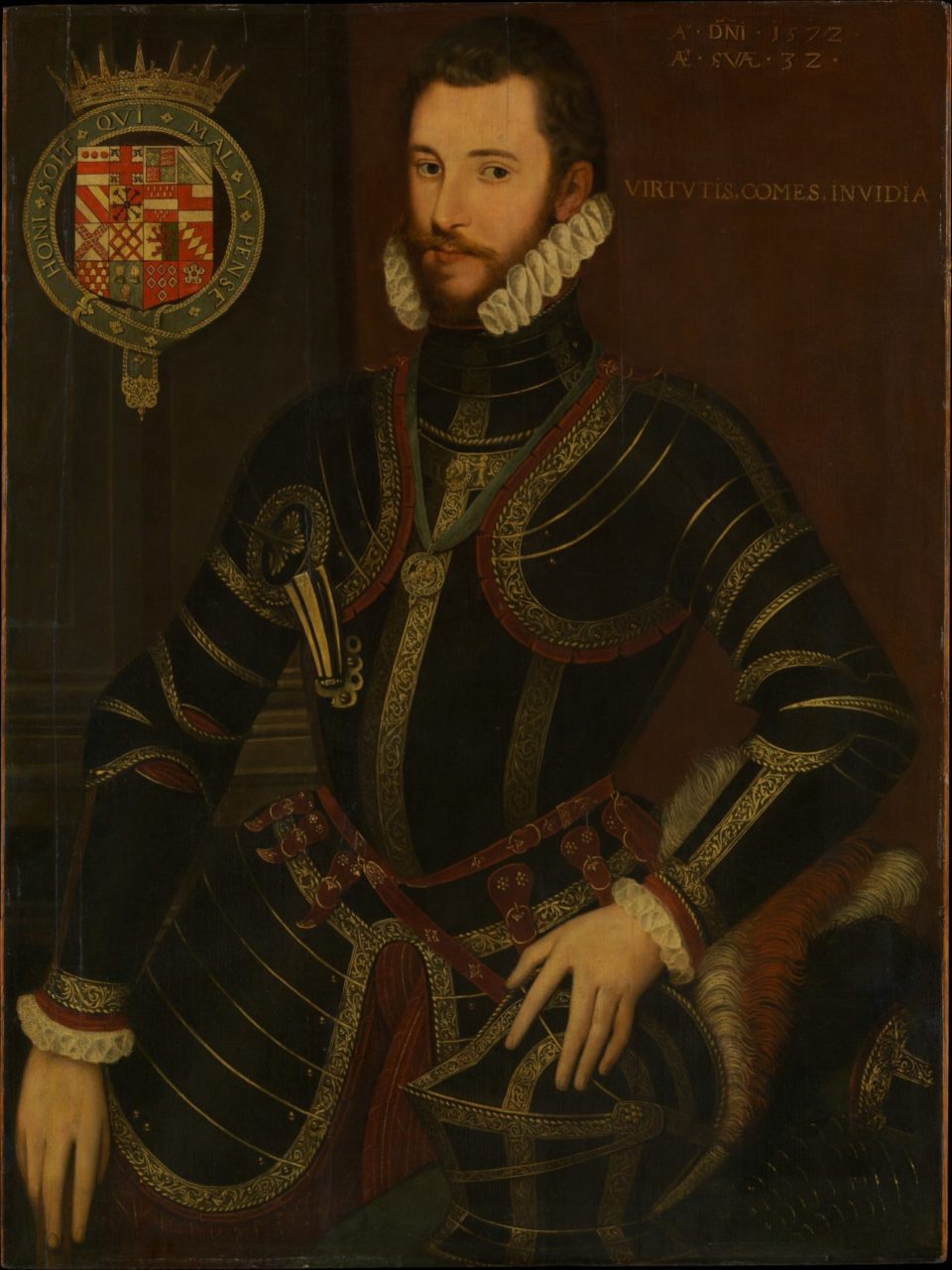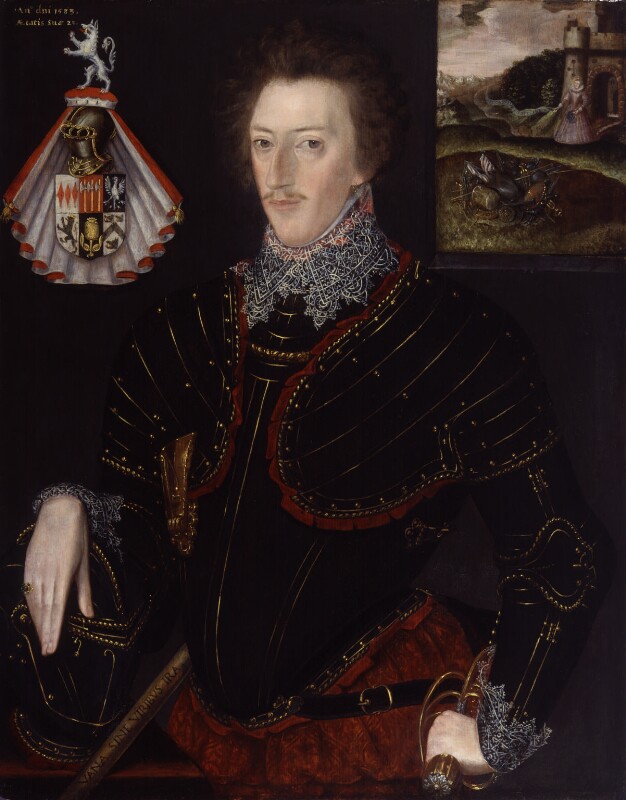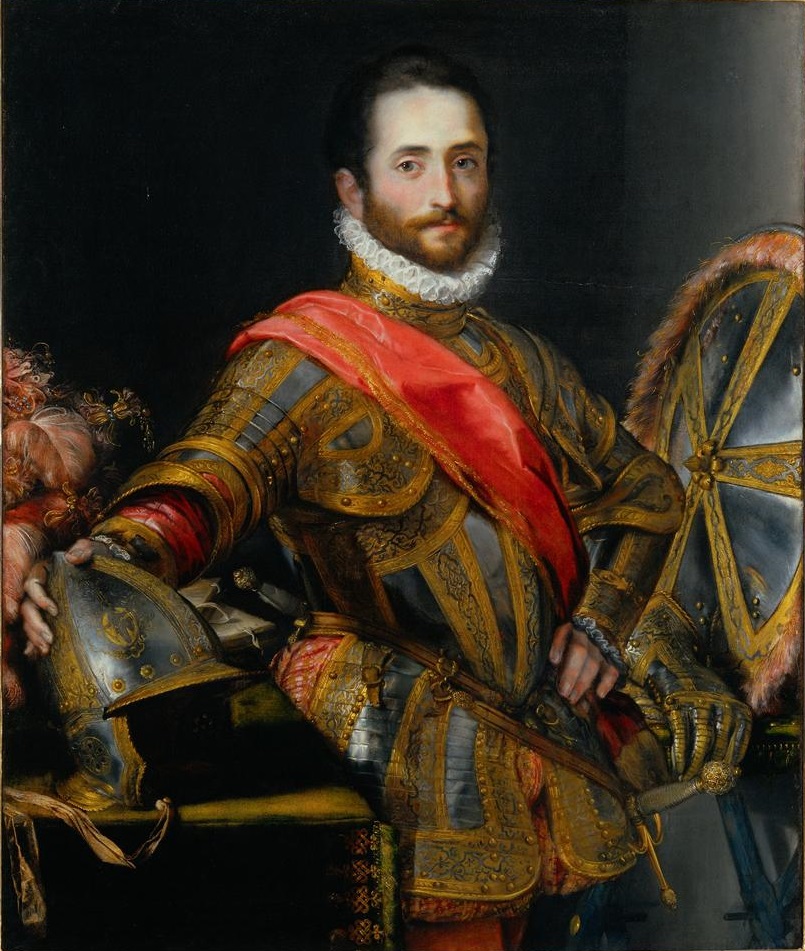From a family with close links to the crown, Sir Walter Devereux rose to great heights on the strength of his perseverance and loyalty. When granted the title of 1st Earl of Essex, he commissioned this portrait of himself. It features him wearing a fashionable mixture of military and civilian costume and suggests an air of hauteur, which his conventional and dignified pose reinforces (Ribeiro 45).
About the Portrait
Although the artist is unknown, what is known is that the painter was British and modeled Sir Walter Devereux’ portrait after Steven Van Herwijk’s portrait of William Herbert, 1st Earl of Pembroke (Fig. 1), as the Met notes. Being that there was no precedent for portraits of Earls of Essex as Devereux was the first, the British painter modeled Devereux’s portrait for his newly acquired title after that of Herbert who was also a first Earl. It would serve as inspiration for yet another portrait in later years (Fig. 2).
As the Met remarks in its discussion of the portrait, it was due to Devereux’s faithfulness to Queen Elizabeth I that the position of Earl of Essex was created and he was installed as a Knight of the Garter in 1572. Yet, even before this, Devereux had a very successful career. In 1558, Devereux succeeded his grandfather as both the Viscount Hereford and Lord Ferrers. Ten years later he was joint custodian of Mary, Queen of Scots. Devereux, in 1569, helped pacify the Northern Rising and was appointed marshal of the Leicester army. Named Lord lieutenant of County Stafford in 1569, he remained active in service of the crown until his death in 1576. (Metropolitan Museum).
Fig. 1 - Steven Van Herwijk (Netherlandish, 1530-1565). William Herbert, 1st Earl of Pembroke (1507-1570), ca. 1560. Oil on panel; 111.5 x 85.8 cm (n/a in). Cardiff: National Museum of Wales, NMW A 16468. Purchased, 2000. Source: The National Museum Wales
Fig. 2 - Artist unknown (Anglo-Netherlandish). Sir Edward Hoby, 1583. Oil on panel; 95.3 x 75.6 cm (37 1/2 x 29 3/4 in). London: National Portrait Gallery, NPG 1974. Purchased, 1923. Source: National Portrait Gallery
Artist unknown (British). Portrait of Walter Devereux (1539-1576), First Earl of Essex, 1572. Oil on wood; 104.5 x 80 cm (41 1/8 x 31 1/2 in). New York: Metropolitan Museum of Art, 20.151.6. Rogers Fund. Source: The Met

About the Fashion
Devereux wears a ceremonial parade amour with gilded, etched red and gold motifs on a blackened ground (Leventon 136). Paired with a gorget to protect the throat, he accented it with the popular ruffled collar, ruff, and matching smaller ruff detailing at the cuffs. Devereux also dons a medal which hangs at his middle chest, a medallion on his right apex, and his sword belt and sword carriage tighten around his waist (Norris 539). Off to his left we can see under his hand is a visored helm or burgonet and metal gauntlet gloves to complete the entire look. During this century deciding whether military or civilian costume inspired the other or vice versa becomes difficult; though one notices amour often will follow similar variations of style as civilian costume, through with less pronounced changes (Boucher 248).
The technique of engraving was often used to decorate on the metal of armor such as Devereux’s instead of techniques such as damasquine or repoussé (Figs. 3-8). Designs were imitated from braid and passementerie motifs, silks, and even interlacing embroidery:
“Furthermore, several specific traits of military costume could also be found in civilian clothes: the shell shape of the codpiece and perhaps the broadening of duck bill shoes, known as solerets. The central ridge of the cuirass, intended to deflect bullets, was imitated in the peascod belly doublet. The slits cut in military costume had originated in the tears received in combat: the thick padding of the sleeves and the chest, originally intended to deaden the impact of blows, became transformed into a fashion and from then on slashing served to show off the lining. This type of sleeve was ultimately reproduced in armour.” (Boucher 248)
Although the painting of Devereux is from mid-thigh up, we can make the guess he is wearing trunk hose which is completed with an apparent codpiece in a matching pattern and color. Like Sir Edward Hobby (Fig. 2), he wears pauldrons made of several plates that curve over both shoulders with their leather lining having been carried beyond the edge of the plates and cut into a tabbed border. The arms are covered in armor with an elbow-guard or cubitiere to provide more flexibility to the wearer. This ease and comfort was to provide the wearer with a sense of using it on a everyday basis:
“As armour conformed to the fashions of civilian dress, the shape of the breastplate was dictated by that of the doublet.” (Ashelford 99)
Fig. 3 - Steven van der Meulen (Flemish, Active 1543-68). John Farnham, Gentleman-Pensioner to Elizabeth I, 1563. Oil on panel; 110.5 x 83 cm (43 1/2 x 32 5/8 in). Worcester: Worcester Art Museum, 1993.36. Charlotte E. W. Buffington Fund. Source: Worcester Art Museum
Fig. 4 - Titian (Tiziano Vecellio) (Italian, 1488-1576). Philip II, 1551. Oil on canvas; 193 x 111 cm. Madrid: Museo del Prado, P00411. Source: Prado
Fig. 5 - Federico Barocci (Italian, 1528-1612). Portrait of Francesco II della Rovere, 1572. Oil on canvas; 113 x 93 cm. Florence: Uffizi Gallery. Source: Virtual Uffizi Gallery
Fig. 6 - Titian (Tiziano Vecellio) (Italian, 1488- 1576). Emperor Charles V (1500-1558) in armor, portrait in half figure, Mid-16th century. Oil on canvas; 110 x 91 cm. Vienna: Kunsthistorisches Museum. Source: Kunsthistorisches
Fig. 7 - Scipione Pulzone (Italian, 1540/42-98). Jacopo Boncompagni, 1574. Oil on canvas; 48 x 39 1/8 in cm. New York: Private Collection. Courtesy Jean-Luc Baroni Ltd.. Source: The Frick Collection
Fig. 8 - Alonso Sanchez Coello (Italian, 1531-1588). Portrait of Alessandro Farnese, 1545-1592. Oil on canvas; 153 x 95 cm. Parma: Galleria Nazionale. Source: Gettyimages
At the time armour was clothing. Nothing spoke more powerfully of a Renaissance nobleman’s honor and standing than his armour and weapons. The aim for these owners who may only commission one or two of the more overly lavish armors in a lifetime was to inspire awe through their appearance, as Victoria & Albert curator Angus Patterson notes:
“Some pieces were designed to kill, others to protect. Most were designed to intimidate, and all were created to impress” (10)
It was because of such grandeur that armor became easily identifiable and less adaptable if stolen. This craftsmanship was English, thanks to King Henry VIII for setting up a royal armory modeled after Emperor Maximilian I and employing both Netherlandish and German craftsmen (Thomas 56). The armory became based out of Greenwich and would soon develop its own style (Thomas 56). In portraits blended costumes involving military and civilian dress became common, as Patterson remarks:
“Except for parades and tournaments, which demanded a more theatrical approach, full plate armor was worn less by the mid-century, and combinations of armour and clothing blurred the lines between solider and civilians. Well-rewarded military commanders keen to show off their new wealth, posed for portraits in rich velvets, fine silks and starched ruffs, but retained elements of armour to emphasize their profession.” (44-45)
References:
- Ashelford, Jane, ed. A Visual History of Costume. London: Batsford, 1983. http://www.worldcat.org/oclc/1010995781.
- Boucher, François. 20,000 Years of Fashion: The History of Costume and Personal Adornment. Expanded ed. New York: H.N. Abrams, 1987. http://www.worldcat.org/oclc/777323433.
- Leventon, Melissa, ed. What People Wore When: A Complete Illustrated History of Costume from Ancient Times to the Nineteenth Century for Every Level of Society. 1st U.S. ed. New York: St. Martin’s Griffin, 2008. http://www.worldcat.org/oclc/836870657.
- Metropolitan Museum of Art. “Portrait of Walter Devereux (1539–1576), First Earl of Essex” Accessed October 18, 2017. https://www.metmuseum.org/art/collection/search/33284
- Norris, Herbert. Tudor Costume and Fashion. Mineola, NY: Dover Publications, 1997. http://www.worldcat.org/oclc/868967373.
- Patterson, Angus. Fashion and Armour in Renaissance Europe: Proud Lookes and Brave Attire. London: V&A, 2009. http://www.worldcat.org/oclc/746081037.
- Ribeiro, Aileen. The Gallery of Fashion. Princeton: Princeton University Press, 2000. http://www.worldcat.org/oclc/500993037.
- Thomas, Bruno, Ortwin Gamber, and Hans Schedelmann. Arms and Armor of the Western World. New York: McGraw Hill, 1964. http://www.worldcat.org/oclc/946985.


















